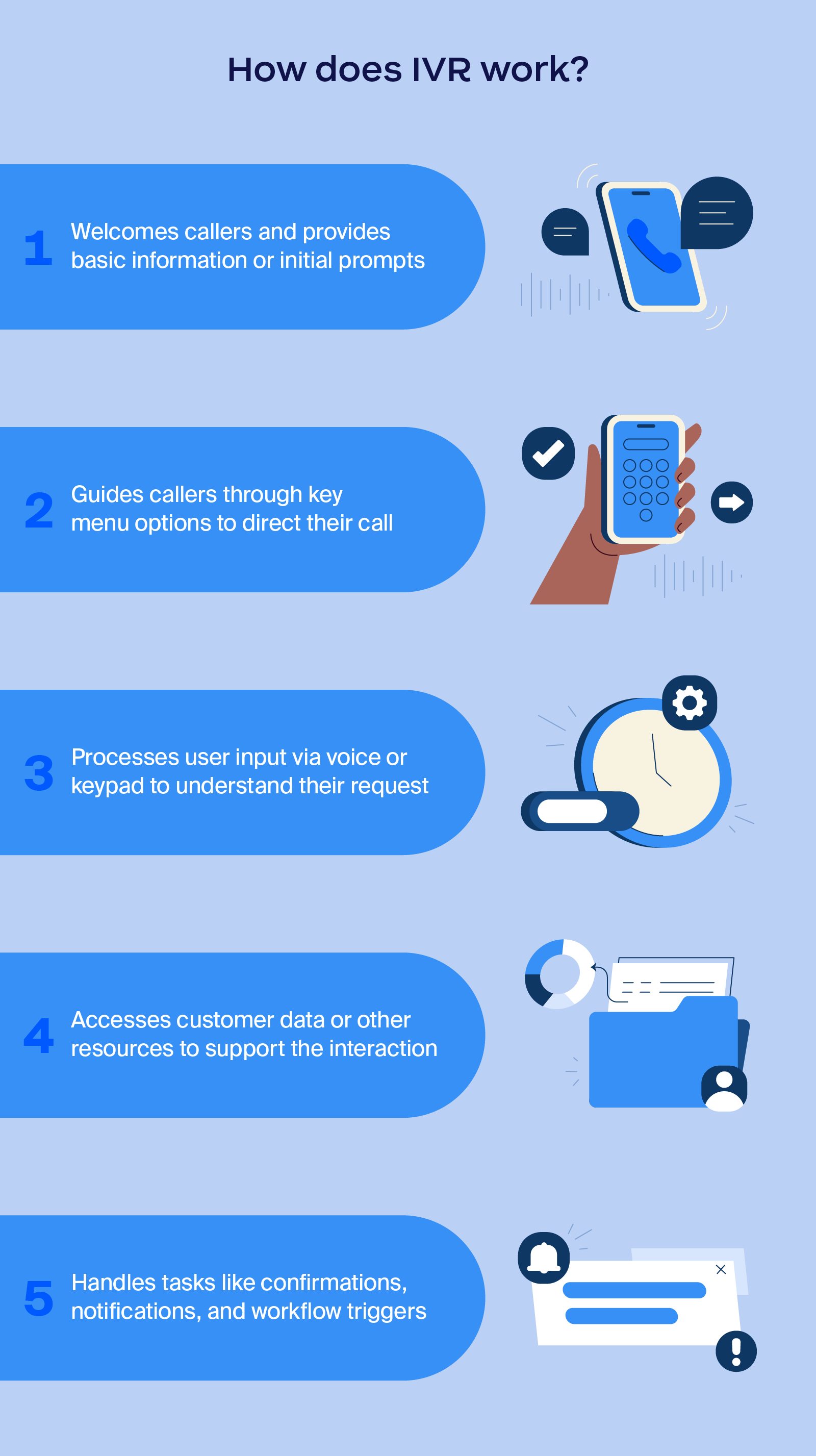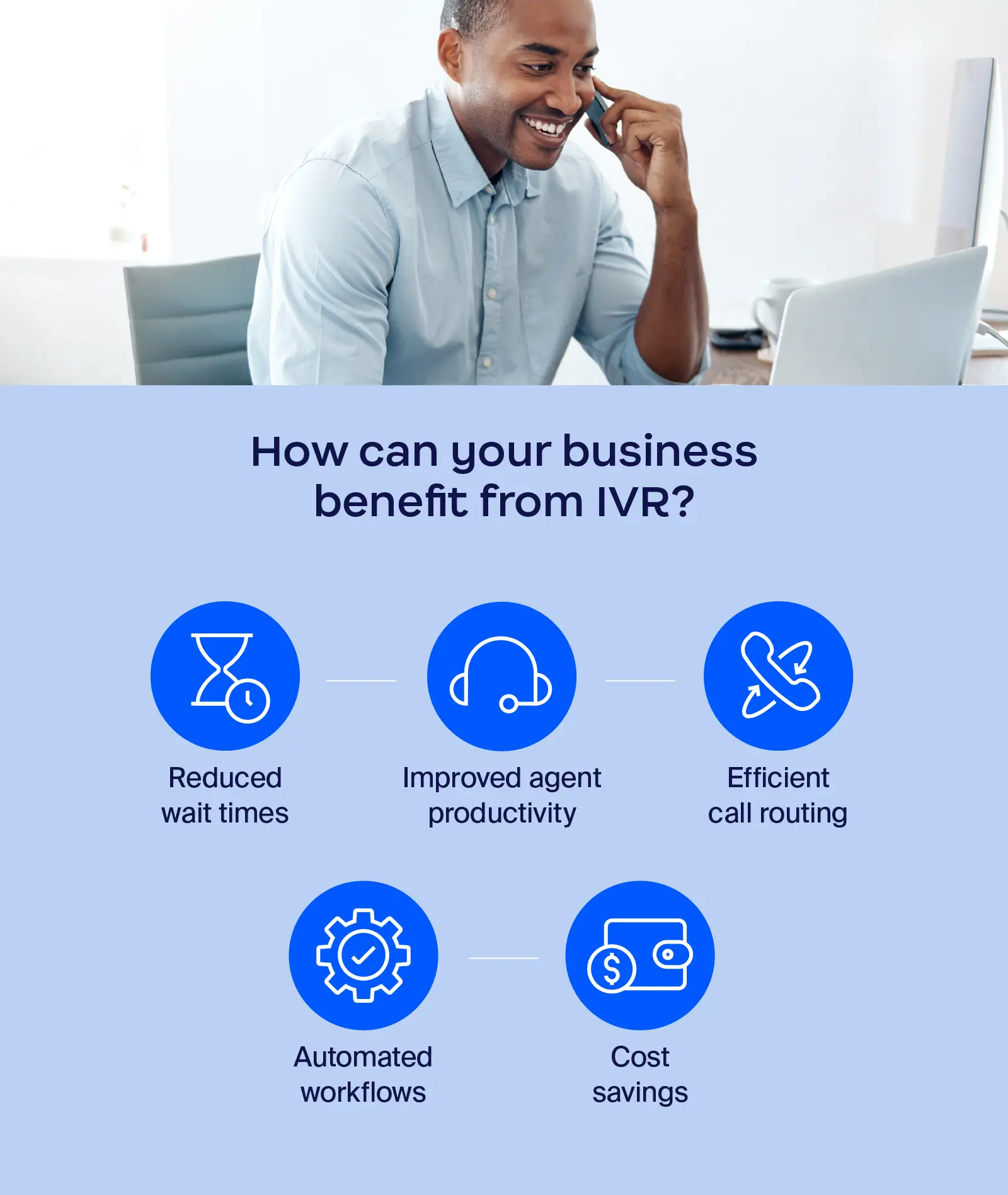
Meet Zoom AI Companion, your new AI assistant!
Boost productivity and team collaboration with Zoom AI Companion, available at no additional cost with eligible paid Zoom plans.
Updated on November 04, 2025
Published on November 04, 2025


If you’ve ever called customer service and encountered an automated voice guiding you through menu options, you’ve used interactive voice response (IVR).
IVR technology allows businesses to manage calls efficiently, enabling callers to interact with automated menus using voice or keypad inputs. It directs callers to the correct department or provides information without human intervention.
IVR is widely used across industries, reducing wait times and helping businesses save up to 30% in call center costs (Grand View Research).
In this blog, we’ll explain how IVR works, why it’s useful, and how it can improve your customer service.
Interactive voice response is a technology that automates phone interactions, allowing callers to navigate through a system using voice commands or keypad inputs. When a customer dials your company’s number and hears a voice prompting them to press certain keys to access specific services or get answers to common questions, they're using IVR.
|
IVR systems automate call routing and provide self-service options, improving the customer experience by reducing wait times and offering 24/7 availability. IVR enhances efficiency and offers the ability to cut operational costs, freeing up human agents for more involved matters. - Sean Fair, Head of AMER CX Sales & GTM, Zoom |
IVR systems can be programmed to answer frequently asked questions, such as business hours, location, or account information, without human intervention. By addressing these simple queries and redirecting callers to the appropriate department, IVR enhances the customer experience. More importantly, IVR frees up your agents to focus on complex issues and high-priority calls, ultimately reducing wait times and further streamlining the customer experience.
IVR systems have transformed the way customers interact with organizations. By automating call handling, IVR offers a convenient and efficient way to access information, perform simple tasks, and get routed to the right department. Let’s take a look at how an IVR system typically works.
This is the first message you hear when you call a customer service number. It welcomes you and sets the tone for the rest of the call. The greeting may also contain information about the service or prompt you to select your preferred language.
Example: You’re calling your bank to change your PIN. You may hear something like: “Welcome to ABC Bank. For English, press 1. Para español, oprima el dos.”
After the greeting, you navigate through the phone tree by selecting the relevant option from the menu based on your needs. You typically use keypad inputs or voice commands to make your selections.
Example: You press 1 for English and are presented with more specific choices: “For account information, press 1. To change your PIN, press 2. To speak with a representative, press 3.”
At this stage, the IVR system processes your input to understand your request. It might use a combination of pre-recorded messages, text-to-speech software, and DTMF tones (the sounds you hear when you press buttons on your phone) to understand your selections.
Some advanced IVR systems also utilize speech recognition technology, enabling you to interact with the system using natural language. This means you can express your needs using complete sentences instead of relying solely on specific keywords or pressing numbers. The system listens to your spoken commands, breaks them down, and matches them against a predefined set of options to determine the correct response or next step.
Example: Instead of saying a keyword like “PIN” or pressing multiple numbers to navigate through menus, you might simply say, “I’d like to change my PIN.” The IVR system recognizes the intent behind your words, allowing for a smoother, more intuitive interaction.

This step involves fetching the information required to complete your request. The system might validate your identity, check account details, or perform other background tasks to authorize you and proceed.
Example: You enter your current PIN, and the system confirms it’s correct. It then asks for your new PIN: “Your PIN has been verified. Please enter your new PIN, followed by the pound key.”
If you need further assistance, the system uses automatic call distribution (ACD) to direct your call to the right representative or department. ACD technology helps make sure that calls are efficiently routed based on factors like customer needs, representative availability, or expertise.
Example: You have another question. The system asks: “If you need further assistance, press 3 to speak with a representative.” You press 3, and it uses ACD to connect you with a customer service agent.
This is the final step, where the IVR system resolves your request or confirms that it’s complete. The aim of this step is for you to be satisfied with the outcome and understand any next steps.
Some IVR systems might ask for feedback at the end of the call to understand customer satisfaction and gather insights for improving the service.
Example: After your call ends, you receive a follow-up prompt asking if you’d like to participate in a brief survey to rate your experience.
IVR systems offer a host of benefits. From reducing call wait times to automating routine tasks, IVR can enhance customer satisfaction and business productivity. Let’s look at these benefits in detail.
IVR systems cut costs because they automate many routine customer inquiries and tasks. This reduces the need for live agents to answer every call, allowing customer service teams to focus on more complex or urgent issues. Plus, IVR can handle multiple calls at once, meaning companies don’t need to hire extra staff just to keep up with high call volumes.
| Pro tip: To improve cost savings, regularly analyze IVR call flow data to identify and optimize the most frequently used paths. Make sure your team is trained to manage any escalations efficiently so they can prioritize tasks accordingly. |
IVR systems boost productivity in customer service. By automating routine tasks like balance inquiries, bill payments, or appointment scheduling, IVR systems free up human agents to focus on more complex issues that need a personal touch.
| Pro tip: Design your IVR menus around your most common customer needs and update them regularly based on call data. This allows customers to quickly get what they need, while agents can resolve issues that require a human touch. |
IVR systems can make a world of difference when it comes to customer experience. They work 24/7, so whether it’s the middle of the night or a holiday weekend, you can still provide basic support.
And let’s be honest — nobody likes waiting on hold forever or being passed around from one department to another. IVR systems solve that problem by directing calls to the right place without all the hassle. They’re also consistent in their responses, so customers know they’ll get the same reliable information every time they call.
IVR systems also accommodate multiple language options, making sure your entire customer base feels welcome and taken care of.
| Pro tip: Regularly review your IVR menu paths and call analytics to identify pain points or drop-off areas. Keep the navigation intuitive and offer an easy way to speak to a live agent so customers aren’t trapped in a never-ending loop of prompts. |
Scaling in relation to IVR refers to the system’s ability to handle increasing levels of call volume or complexity without degrading performance. As your business grows, the number of customer interactions typically rises. IVR systems can grow with you by accommodating more calls simultaneously, adding new features, and integrating with other business tools.
For example, to accommodate a surge in call volume during the holiday season, a retail business might scale its IVR system by adding additional server resources, transitioning to a cloud-based solution, or integrating with other customer support systems to manage the increased load.
| Pro tip: To scale your company effectively, use analytics to forecast demand and identify when to expand IVR capacity. Choose an IVR platform that allows for easy integration with CRMs and ticketing tools so your support infrastructure grows in sync with your business. |
When callers interact with an IVR system, they’re not just navigating through menu options — they’re forming an impression of the company. A well-designed IVR presents a professional image, which can enhance the way customers view your brand. It sends a message that the company is modern, efficient, and values customer experience.
Using voice recognition technology, IVR can offer more natural and personalized responses, making interactions smoother and less robotic. This human-like touch helps callers feel more at ease and understood, boosting their perception of the company’s professionalism.
| Pro tip: Keep your IVR menu concise and easy to follow to make a strong first impression. For the voice recording, consider hiring a professional voice actor (either through a voice talent agency or platforms like Fiverr) for a polished, professional experience. Provide them with a clear script to help maintain consistency. After it’s recorded, review and test the prompts to make sure it works for customers. |

Various industries use IVR systems to streamline customer interactions and improve efficiency. From healthcare to banking and finance, IVR technology helps organizations manage high call volumes, provide 24/7 service, and automate routine tasks, allowing live agents to focus on more complex customer needs.
The healthcare industry uses IVR systems to streamline patient communication and reduce the administrative workload. They allow patients to schedule or reschedule appointments without waiting on hold, making it easier to manage bookings.
IVR can also facilitate prescription refills, letting patients order their medications with a simple phone call. Additionally, it can handle patient pre-screening, and collecting important information ahead of a medical appointment to speed up the check-in process.
|
IVR systems significantly enhance the patient experience and operational efficiency by automating tasks such as appointment scheduling, prescription refills, and providing lab results 24/7. This approach reduces the administrative burden on staff, allowing medical personnel to focus more on patient care. - Jason Wyant, Zoom Contact Center Specialist - Healthcare |
In the banking and finance sector, IVR systems offer customers a quick and convenient way to manage their accounts and complete basic transactions. These systems allow customers to check their account balances, transfer funds, or inquire about recent transactions without speaking to a representative.
Financial organizations can use IVR to provide information about loans, interest rates, or other financial products, helping customers find what they need quickly and easily. This reduces wait times and allows human agents to focus on more complex customer inquiries.
|
In the finance and banking sector, IVR systems can enhance security through authentication measures, aid in fraud detection, and reduce operational costs. - Tanner Trosper, Zoom Contact Center Specialist |
In the retail industry, IVR systems play a key role in improving the customer experience by providing quick access to common services. For example, customers can use IVR to get real-time updates on their order status so they know when to expect deliveries.
Retailers also use IVR to offer store locator services, helping customers find the nearest location or check store hours. Additionally, IVR can provide product information, allowing customers to learn about features, availability, or pricing with a simple phone call. Programmable IVR menus can also complement lead generation by capturing callers’ intent as they answer a few questions before they’re passed to the right department.
|
IVR can help simplify order tracking, product inquiries, and customer support, offering shoppers convenient self-service options and freeing up staff. The systems can also provide callers with information on discounts and promotions. - Randy Maestre, Head of AI, Developer Ecosystem and Industry Marketing, Zoom |
Service providers — such as utilities or telecom companies — rely on IVR systems to manage customer inquiries and transactions. IVR allows customers to check their bills, make payments over the phone, or inquire about their account balance. It can also facilitate plan changes, letting customers upgrade or modify their service without waiting to speak to a representative.
For technical support, IVR can guide customers through basic troubleshooting steps, reducing the need for live assistance and speeding up the resolution of common issues.
The travel and hospitality industries use IVR to enhance customer experience by automating essential services. They allow customers to make bookings and reservations without waiting on hold. IVR can also provide real-time travel updates, such as flight delays or gate changes, keeping travelers informed.
Additionally, travel companies use IVR for loyalty program management, allowing customers to check their points, redeem rewards, or update their membership information with ease.
|
Within the hospitality industry, IVR systems can improve the guest experience by automating common tasks such as reservations, check-ins, and check-outs, as well as requests like room service or wake-up calls. - Tommy Hart, CX/AI Specialist, Zoom |
Government agencies leverage IVR to communicate with the public and streamline services. IVR can be used for information dissemination, providing details about government programs, office hours, or locations.
It can also facilitate public feedback collection, allowing citizens to share their opinions or report issues through automated surveys. In times of crisis, IVR systems play a critical role in sending emergency notifications and providing timely communication to keep communities safe.

Creating a user-friendly IVR menu is key to ensuring a smooth and satisfying experience for your callers. Here are some simple yet effective tips to help you design a menu that’s intuitive, efficient, and considerate of your customers’ time.
When designed thoughtfully, IVR systems can play a vital role in making services more inclusive and accessible to all customers, including those with disabilities. A well-laid-out IVR phone system can reduce communication barriers and help provide equal access to support and information.
Use a cloud-based contact center platform like Zoom Contact Center for your IVR needs. It’s designed to simplify customer interactions while providing a seamless user experience.
With Zoom Contact Center, you can set up customized IVR menus, use ACD, and automate workflows to help your customers find what they need quickly and efficiently. This flexibility helps improve customer satisfaction and streamline business processes.
Ready to get started with a more effective IVR system? Contact us today.
Do you have more questions about an IVR, such as its meaning or how to integrate it into your business operations? We’ve got you covered with answers to some of the most frequently asked questions.
IVR stands for interactive voice response, a technology that allows callers to interact with a company’s phone system through voice commands or keypad inputs. After they pick a path, the system allows them to access information or complete tasks without interacting with a live agent unless they need one.
For example, callers could call your number and be greeted with: “Press 1 for customer support, press 2 for billing, or press 3 to speak with a live agent.”
Companies leverage IVR to streamline customer service by automating routine inquiries and call routing. This can improve efficiency, reduce wait times, lower operating costs, and enhance customer satisfaction by easing wait times. Additionally, an IVR phone system reduces the need to hire a larger customer support team, so you can lower overhead costs while still maintaining a responsive and scalable support system.
Beyond cost and efficiency, IVR systems help businesses provide consistent experiences across all hours and geographies. Customers can access information or get help anytime without needing a live agent. This accessibility improves customer loyalty, business continuity, and service quality. It’s a great solution to meet modern expectations of businesses.
A call center has a team of live agents ready to take any customer’s calls and help them in real time. They are trained to offer personalized assistance for various issues or inquiries. These agents provide direct human interaction, helping to resolve complex issues or address sensitive situations.
An IVR is an automated system many call centers use to gather customer information and route calls to the appropriate representative if needed. IVRs can help manage high call volumes, so fewer agents are needed to handle all of them.